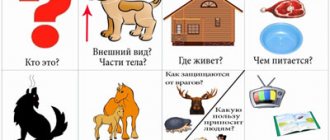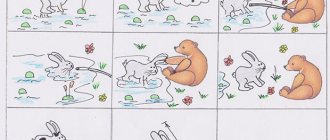Effective memorization techniques
Memorizing is building a long-term imaginary connection with something: a date with an event, information with a program or a certain course. Psychologists call such processes “associative connections.”
Memorizing numbers using mnemonics
Important! It happens that a person begins to reproduce the material poorly. This process is characterized by frequent memory lapses and forgetting. Similar phenomena can occur in people of different ages. Don't worry about this right away. As a rule, this usually happens due to the fact that the brain filters out unnecessary information. There is a “cleansing” of knowledge that has not been used for many years. Such moments are very individual and depend on the structure of the brain. It should also be remembered that a child’s body is different from an adult’s and is formed until adolescence.
Currently, there are many effective memorization techniques. They are used by authors to create their books, many of which can be found in audiobook format and listened to online or downloaded. Also today there are proprietary courses on memorization techniques taught by professional psychologists and specialists.
The most common methods:
- Multisensory reception. Impacts on receptors during the process of memorization.
- Mnemonics. It is used in speech therapy and pedagogical practices when working with children from 3 years old and in the preschool period when studying poems, stories and other information.
- Associative practice. Helps immerse the brain in a labyrinth of logical chains, learn to connect an object with the desired event.
- Sorting of material. It is suitable for those who like to develop memory by classifying material into topics and blocks.
- "Buffet". Memorizing information in a row, without breaking it down into subtopics.
- Dropping words. This involves writing out material manually and discarding unnecessary text.
- Rhyme and numbers. Rhyme is used when remembering rules, and numbers are used when learning numbers (for example, 0 is a donut, 2 is a swan).
Mnemonics and mnemonics
Mnemonics are used for the following:
- Facilitate memorization and increase memory capacity;
- Development of cognitive activity;
- Development of the main mental processes, as well as auditory and visual memory;
- Improves thinking skills, imagination, coherent speech and fine motor skills.
Mnemonic table for dishes
Using mnemonics, the following processes are facilitated:
- Enrichment of vocabulary;
- Writing stories;
- Guessing riddles;
- Memorizing poems.
A long-term lesson plan to familiarize yourself with the world around you
Rules for children memorizing information
7 main rules:
- First, arouse the baby’s interest and intrigue.
- Create associations. The better it is, the better the information will be perceived.
- Remember in parts. Under no circumstances should you require your child to know the text by heart in one sitting.
- Repeat what you memorized.
- Trying to understand the material means creating logical chains in thinking.
- Setting a goal to “remember.”
- Apply knowledge of this information in practice. For example, when memorizing a poem by heart, tell it to parents, teachers and the group more often.
Mnemonics for beginners: exercises for children, games
Exercises for beginners on mnemonics for children are always exciting and interesting. These can be mnemonic tables, mnemonic techniques, exercises.
DIY mnemonic table
Note! The principle of mnemonics is the creation of visual, auditory and sensory representations.
Exercises:
- Consonances. Thanks to constant repetition, the word is remembered: “Like there is snow on the hill, snow, and under the hill there is snow, snow. And there's a bear sleeping on the hill! Quiet, quiet, don’t make any noise!”
- Tables. Help the baby build coherent speech. With their help, they study fairy tales, seasons, and poems.
- Rhymes. Rhymes are selected for words that are difficult to remember: grass-owl, rumor, where.
- Scheme. To remember numbers. For example, an association word is written for each number: 4 - chair or armchair.
Mnemonics based on fairy tales: a technique for preschool teachers
Memory training for children is also carried out by teachers in preschool educational institutions. In this case, reference diagrams and mnemonic tables are selected from the mnemonics. Education begins at one or two years of age, since during this period the baby already knows some fairy tales and can tell them. However, he often confuses characters from different fairy tales. Mnemonic tables will help you remember the main characters of a given fairy tale.
Mnemonic table based on the fairy tale “Kolobok”
Illustrations of fairy tale characters are placed in the table cells. The fairy tale “Kolobok” is especially convenient for teaching, since it has many characters.
Additional Information! For the youngest students, four cells or no more than nine are enough.
During the learning process, the teacher draws images in the cells of the table with the children. This is very exciting for children, and later they can begin to come up with such tables and images themselves.
Teaching preschoolers to read - what it gives and when you can start teaching
Memory improves due to the constant encoding of information into pictures and vice versa, and is also reinforced verbally.
Principles of operation of mnemonic tables
Note that to encode a poem, even the simplest image for a line or an entire quatrain is sufficient. It is not necessary to be a professional artist to depict the objects or actions described in the work. In a mnemonic table it is possible to schematically display the entire world around us: natural phenomena, events, signs of objects, actions of characters. The method of mnemonic tables has been developed in detail, with the necessary instructions, which does not cause difficulties in application.
The scope of the article does not imply an extended description of the methodology, so we will focus on its main principles. Work begins with the construction of a mnemonic square that corresponds to a specific word. For example, the poem “White Birch” by Sergei Yesenin is memorized. Using the word “birch,” the teacher suggests considering the symbolic designation of a tree. This should be a simple and accessible drawing for children that they can complete on their own. Then we do the same with other words, for example, “window”, “snow”, “branches”, etc. So children begin to gradually understand what the symbol of the word means.
At the beginning of training, colored mnemonic tables are offered, since color images quickly appear in children’s memory: snow is white, spruce branches are green, the sky is blue. Then, as specific skills in depicting objects are mastered, black and white symbols are used so as not to be distracted by their brightness.
Subsequent work on the poem involves a gradual transition from mnemonic squares to mnemonic tracks, which designate entire poetic phrases. This is how the poem is gradually memorized and reproduced using conventional symbols.
After mastering the necessary initial knowledge about symbols, children are led to actions with mnemonic tables. The number of cells in the table depends on the complexity and size of the text, as well as on the age of the students. Thus, the entire poem is recorded schematically.
Teachers note that as they learn, children are actively involved in creating their own scheme. After this, they reproduce the entire text from memory, using only a symbolic image.
Methods for diagnosing the memory of preschoolers
Diagnosing memory in preschoolers using techniques is necessary to identify the effectiveness and adequacy of the training provided and to improve further educational techniques. After diagnosis, the development plan and the children’s learning model are adjusted.
Important! Diagnosing the memorization process in children at an early age will help to avoid possible violations in this process and take the necessary measures in time.
Memory techniques for preschoolers:
- Mastering the material
- Playback,
- Quality of information storage.
Visual, auditory and motor memory work during the diagnostic process.




